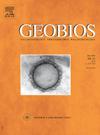再次进行时间扭曲:电子自旋共振测年揭示了1888年Notiomastodon platensis Ameghino最古老的数字年龄(哺乳动物,长鼻目)
IF 1.6
4区 地球科学
Q2 PALEONTOLOGY
引用次数: 0
摘要
本文利用电子自旋共振(ESR)测年方法,对阿根廷Córdoba省第四纪长鼻目Notiomastodon platensis Ameghino 1888化石标本进行了时间和地理分布的更新。虽然南美晚更新世/全新世早期化石记录丰富,但由于数值测年数据有限,对该类早-中更新世化石记录的了解很少。ESR结果显示,该物种的年龄范围为560±40 ~ 47±7 ka,处于更新世的Ensenadan至Lujanian阶段(Chibanian至晚更新世)。Ensenadan记录代表了南美洲Notiomastodon platensis最古老的数字年龄。该研究强调了数值测年在解决南美巨型动物地质年代学数据缺口方面的重要性,揭示了第四纪中非乳齿象(Notiomastodon platensis)居住的多种环境,表明它们在气候变化的影响下进行了缓慢的垂直迁移,科尔多瓦省的山区是它们的避难所。本研究强调需要进一步的数值定年,以提高我们对第四纪南美长鼻目动物的进化史和灭绝驱动因素的理解。本文章由计算机程序翻译,如有差异,请以英文原文为准。
Doing the time warp again: Electron Spin Resonance dating reveals oldest numeric age for Notiomastodon platensis Ameghino, 1888 (Mammalia, Proboscidea)
Here we used Electron Spin Resonance (ESR) dating methods on seven fossil specimens to update the temporal and geographic distributions of the Quaternary proboscidean Notiomastodon platensis Ameghino 1888, from Córdoba Province, Argentina. While abundant in the Late Pleistocene/Early Holocene South American fossil record, the knowledge about the Early-Middle Pleistocene records of this proboscidean is scarce due to limited numeric datings data. ESR results reveal numeric ages ranging from 560 ± 40 to 47 ± 7 ka, placing the species within the Ensenadan to Lujanian stages of the Pleistocene (Chibanian to Late Pleistocene). The Ensenadan record represents the oldest numeric age of Notiomastodon platensis in South America. The study highlights the importance of numeric dating in addressing the geochronological data gap for South American megafauna and reveals the multiple environments that Notiomastodon platensis inhabited during Quaternary, suggesting slow vertical migrations in response to climatic changes, with mountainous regions of Cordoba province serving as refuges. The need for further numeric datings is emphasized in this study, to improve our understanding of the evolutionary history and extinction drivers of South American proboscideans during the Quaternary.
求助全文
通过发布文献求助,成功后即可免费获取论文全文。
去求助
来源期刊

Geobios
地学-古生物学
CiteScore
3.30
自引率
6.20%
发文量
28
审稿时长
6-12 weeks
期刊介绍:
Geobios publishes bimonthly in English original peer-reviewed articles of international interest in any area of paleontology, paleobiology, paleoecology, paleobiogeography, (bio)stratigraphy and biogeochemistry. All taxonomic groups are treated, including microfossils, invertebrates, plants, vertebrates and ichnofossils.
Geobios welcomes descriptive papers based on original material (e.g. large Systematic Paleontology works), as well as more analytically and/or methodologically oriented papers, provided they offer strong and significant biochronological/biostratigraphical, paleobiogeographical, paleobiological and/or phylogenetic new insights and perspectices. A high priority level is given to synchronic and/or diachronic studies based on multi- or inter-disciplinary approaches mixing various fields of Earth and Life Sciences. Works based on extant data are also considered, provided they offer significant insights into geological-time studies.
 求助内容:
求助内容: 应助结果提醒方式:
应助结果提醒方式:


